
A busman’s holiday or Ecologists in paradise
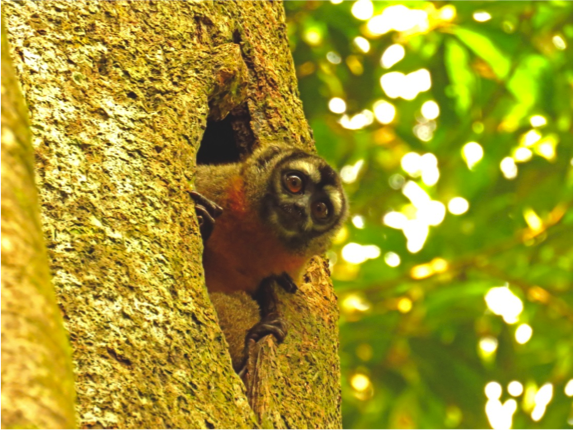
By Dr. Dave Swift
In February of 2015, Bill Parton and I and our respective wives, Lenora and Liliana, were fortunate to take a cruise on the Peruvian Amazon. With the exception of me and my wife, all of the passengers were members of the Parton’s extended family. We explained our presence by saying that Lili was from the Argentine branch of the family, which was true if you didn’t specify what family you were talking about. At any rate, that seemed to provide us some sort of authenticity, and we were accepted into the group. The trip was arranged by the Smithsonian Institute’s Travel Program and was exceedingly well organized and pleasant: The cabins were comfortable and air conditioned, the food was great, and we had live music for dancing every night in the bar – provided by the “Chunky Monkeys”. It turns out that to earn a position as a guide on the cruise, the Smithsonian required an audition for musical skills; so the Chunky Monkeys were the same folks who waited tables, cooked and cleaned the boat and led our birding expeditions with. The theory was, I suppose, that it is easier to teach a musician to wait tables than to teach a waiter to play the guitar.
The cruise began at the city of Iquitos, a city of about a half a million people but with no roads in or out. Everything that enters or leaves the city does so either by air (as we did, from Lima) or by boat – mainly from Brazil. Still, the place is a real, modern city with cathedrals, four star hotels, etc. From Iquitos we went upstream to the confluence of the Ucayali and Marañon Rivers, which (according to Peruvians) is where the actual, flesh and blood Amazon begins. Any Ecuadorian who tells you that the Amazon rises in Ecuador is delusional. We poked up the Ucayali (which translates to “canoe breaker” due to some severe rapids upstream) for several days then came back down to the confluence, up the Marañon and then back to Iquitos – all together about 10 days.
Twice a day we divided into two groups and each boarded a motorized launch that allowed us to penetrate up some of the numerous tributaries and back waters along the river. Each launch had a local and very knowledgeable and sharp eyed naturalist on board. The birding was spectacular, as was the lizarding. We saw numerous very handsome lagartos, look at the fellow below. In particular note his hind feet – clearly not designed (if I dare use that word) for a terrestrial life.
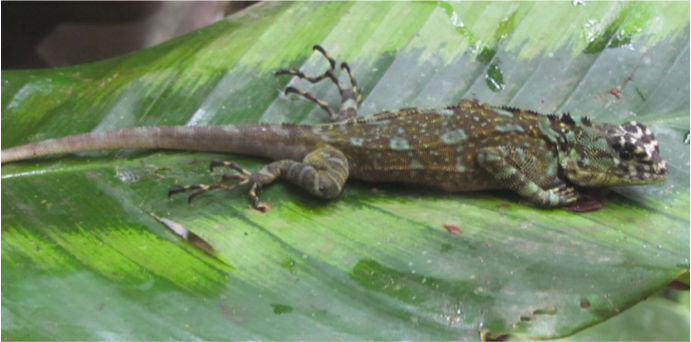
1. The Flood Pulse System Feeds the Amazon Fishery
One of the really interesting things we learned about the hydrology and ecology of the river is the enormous difference in the stage (the elevation of the surface of the river) and its lateral extent between the wet and dry seasons. The stage may vary by as much as 10 meters over the course of a year; and since the surrounding areas are usually quite flat, the river makes very substantial incursions into the rainforest on both sides. We were unable to go into this seasonally flooded forest while we were there, because it was the wet season and these areas were inundated. The phenomenon of the flood pulse system has enormous ecological consequences for the biota of the river. For quite a long time it was not understood how the Amazon could support the very productive fishery that it does. The problem being that there are two types of waters in the Amazon system – the white water portion of the main stem (white because it is sediment loaded) and the black water tributaries that rise locally – and neither of these supports much primary production. The white waters are too opaque to allow much light penetration and so photosynthesis is low. The black waters allow light to penetrate but they are generally so low in nutrients that they don’t support much primary production. Since primary production must form the base of the food chain that the fishery depends on it was difficult to explain the very productive fish population. The answer is that during the wet season, the fish leave the main channel and go into the temporarily flooded forest to graze on vegetation on the forest floor. As the waters recede, the fish return to the channel, fat and happy. I can think of no other situation in which terrestrial and aquatic systems are so profoundly linked. There is some talk of building dams on the Amazon to regulate its flow. Imagine the unintended consequences that could result from such activities.
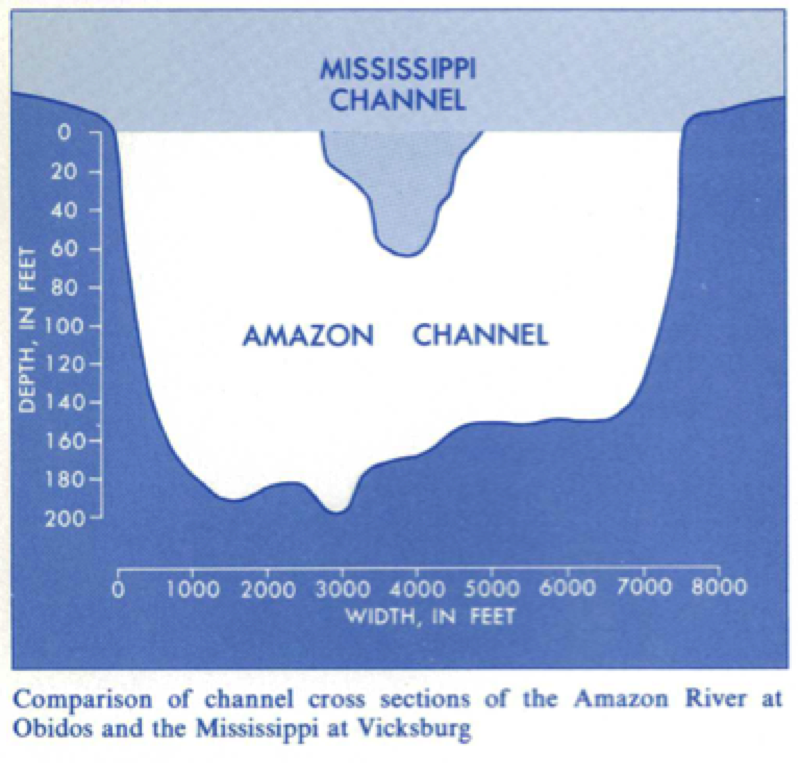
The Amazon as you know is an enormous river. We were told that where we were, near Iquitos, it was carrying only about 10% of the volume of discharge it would have at the Atlantic; so it was hardly beginning to get going, and it was already very large. Above you can see a comparison of the channels of the Amazon and the mighty Mississippi – “The father of waters”. The point on the Amazon is about half way between Manaus, Brazil and the Atlantic, so it is still a pretty good distance upstream from its mouth.
2. The Only Bird that Looks like a Cow From the Inside
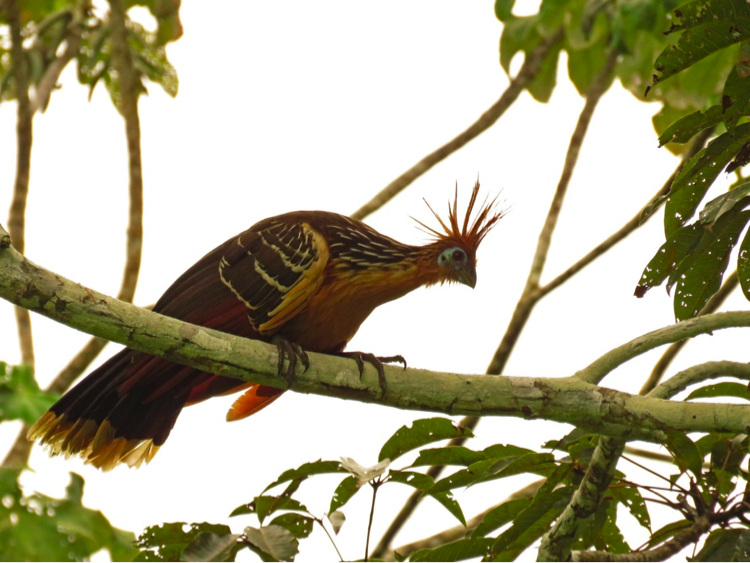
Another thing that I really enjoyed was finally seeing the notorious hoatzin (Opisthocomus hoazin). This unique bird has a digestive system very similar to a cow’s: It has an enlarged chamber at the lower end of its esophagus in which microbial fermentation of ingested vegetable matter occurs, degrading cellulose and releasing energy bearing volatile fatty acids to the bird. This is basically the same thing that cattle and other ruminants do, but the hoatzin is the only bird that has ‘figured it out’. I would always talk about this bird when I taught animal nutrition, but had never (until now) seen one! The benefit of this digestive approach is that it allows the bird to take advantage of cellulose, the most abundant carbohydrate on earth and really nothing more than long chains of glucose molecules hooked together. We, the metabolically incompetent mammals, as well as birds, do not possess the enzymes necessary to break cellulose into its glucose units, thus we usually can’t and don’t eat grass. Cattle and other ruminants have evolved (if I dare use that word) symbiotic relationships with numerous bacteria that do possess the necessary enzymes. Thus we exploit the cellulose of grasslands indirectly by letting the ruminants and their symbionts do the work for us. I was so pleased to have seen this bird that I imposed upon the trip organizers to allow me to discuss all of this in a presentation after dinner one evening. That’s what they get for allowing professors to go on these trips.
3. Mythical Pink Dolphins Do Still Exist
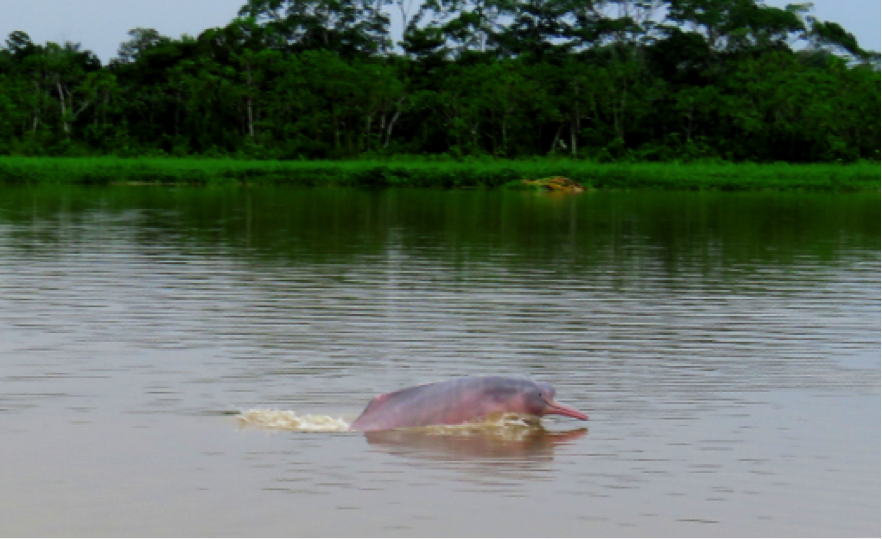
The Amazon is also home to a very interesting fresh water dolphin; and we saw these little cetaceans quite often. Most dolphins are, of course, salt water creatures but there are five species that have adapted to fresh water habitats. The Amazon River dolphin, Inia geoffrensis, is the largest of the five and is found in both a pink and whitish shade. They apparently developed during the mid-Miocene when the Amazon basin was a shallow inland sea. In the local folklore of the ribereños, pink dolphin were once people but gave up on the terrestrial life style, mostly. Still, it is felt they come ashore from time to time and are held to be responsible for otherwise inexplicable pregnancies among the younger ribereñas. The persistence of this calumny is apparently due in part to certain anatomical similarities between male humans and male dolphins.
This trip was one of the best organized, informative, and engaging adventures I’ve had the pleasure to participate in. As a semi-retired scholar I now have the time (if not the money) to do what I want, whether that involves birding and cultural exploration in the Amazon or teaching other amateur naturalists about animal nutrition. Combining those interests through organized travel—e.g. with the Smithsonian Institution—is an experience I highly recommend to scholars, students, and amateur naturalists alike.
Dr. Dave Swift is a senior research scientist at Colorado State University, he focuses his research on large animal ecology and nutrition around the world.